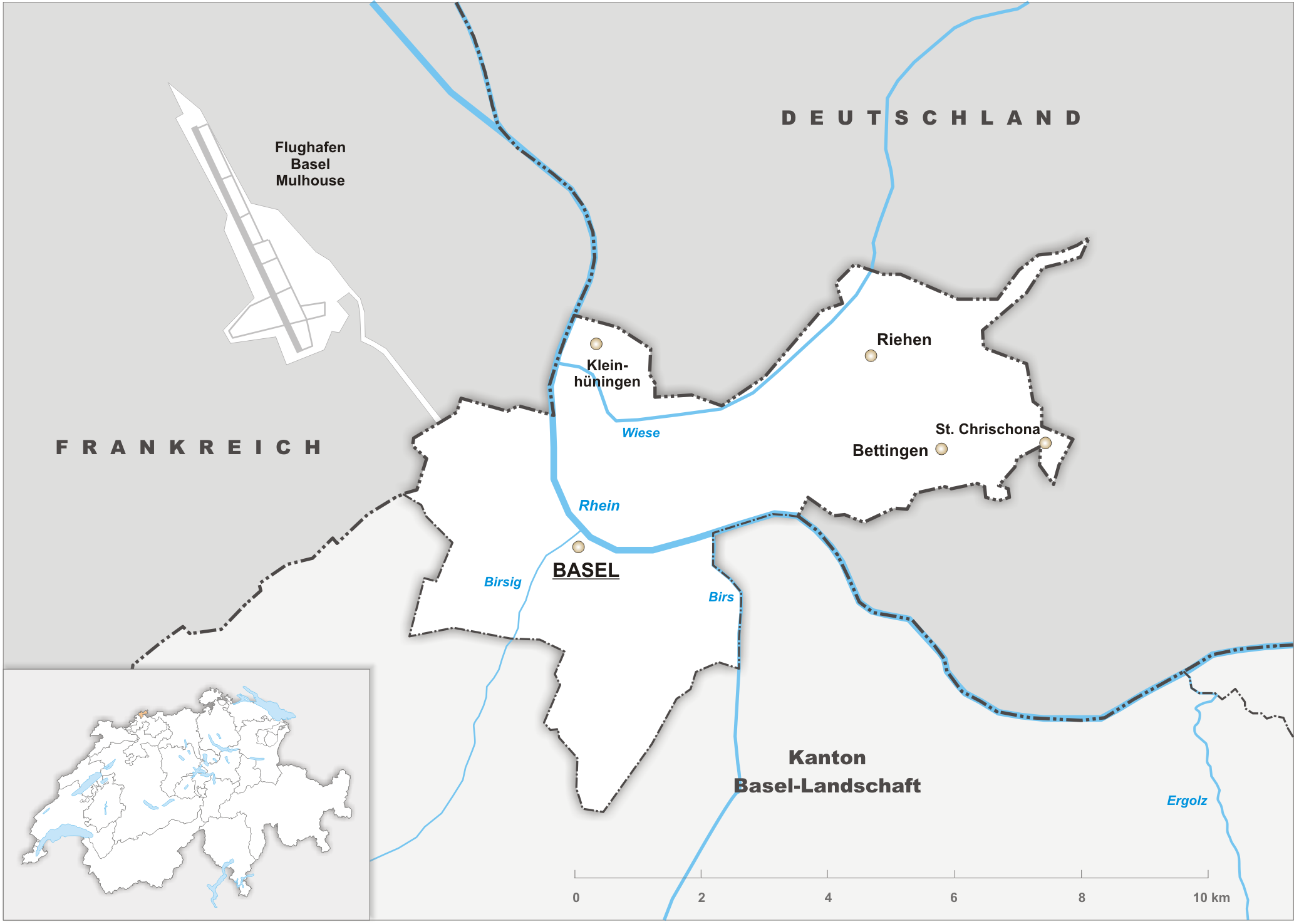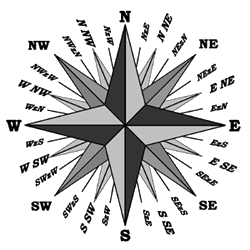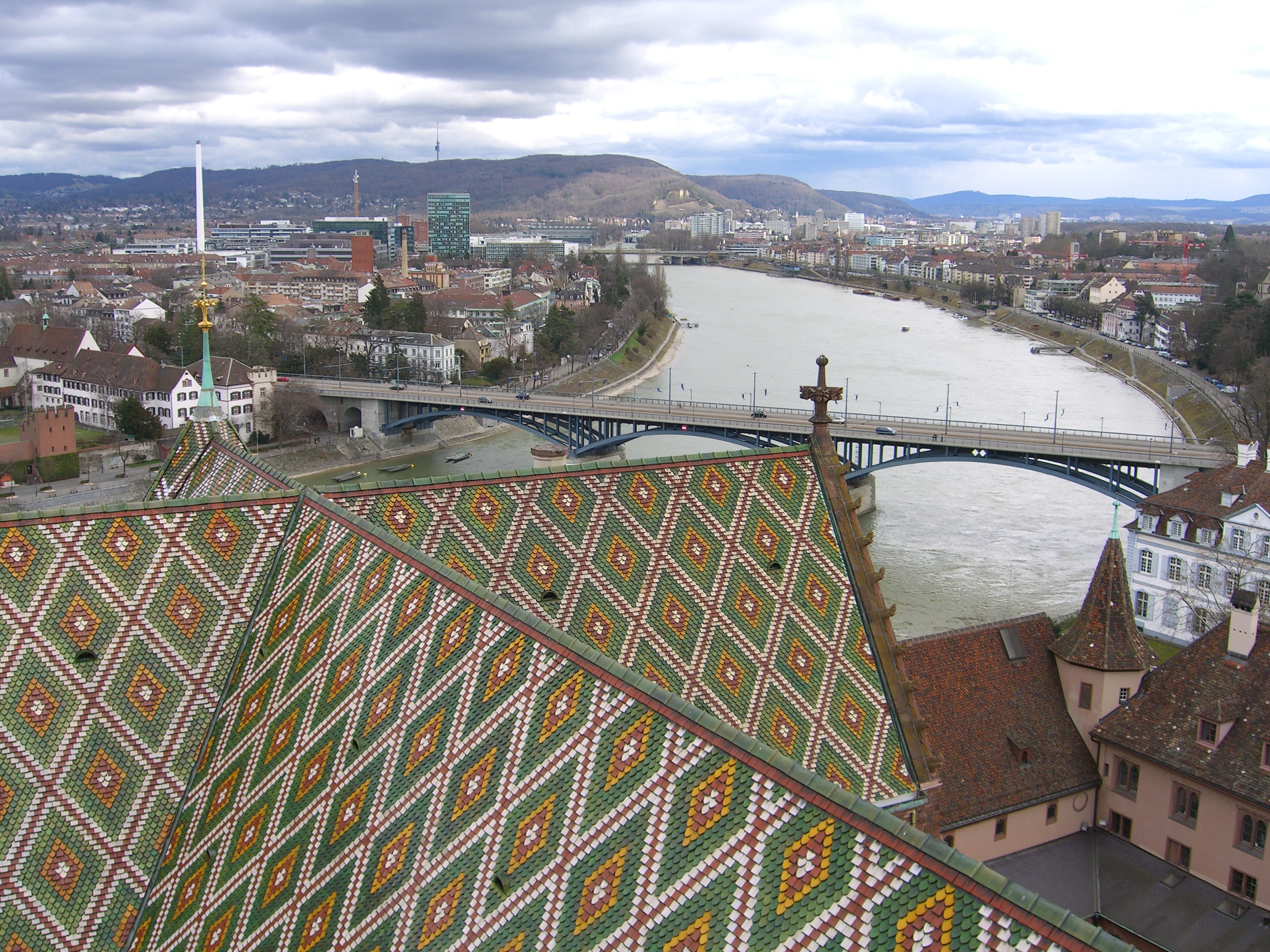|
Canton Of Basel-Stadt
Basel-Stadt or Basel-City (german: Kanton ; rm, Chantun Basilea-Citad; french: Canton de Bâle-Ville; it, Canton Basilea Città) is one of the 26 cantons forming the Swiss Confederation. It is composed of three municipalities with Basel as the capital. It is traditionally considered a "half-canton", the other half being Basel-Landschaft, its rural counterpart. Basel-Stadt is one of the northernmost and lowest cantons of Switzerland, and the smallest by area. The canton lies on both sides of the Rhine and is very densely populated. The largest municipality is Basel, followed by Riehen and Bettingen. The only canton sharing borders with Basel-Stadt is Basel-Landschaft to the south. To the north of Basel-Stadt are France and Germany, with the tripoint being in the middle of the Rhine. Together with Basel-Landschaft, Basel-Stadt was part of the canton of Basel, who joined the Old Swiss Confederacy in 1501. Political quarrels and armed conflict led to the partition of the canton ... [...More Info...] [...Related Items...] OR: [Wikipedia] [Google] [Baidu] |
Cantons Of Switzerland
The 26 cantons of Switzerland (german: Kanton; french: canton ; it, cantone; Sursilvan and Surmiran: ; Vallader and Puter: ; Sutsilvan: ; Rumantsch Grischun: ) are the member states of the Swiss Confederation. The nucleus of the Swiss Confederacy in the form of the first three confederate allies used to be referred to as the . Two important periods in the development of the Old Swiss Confederacy are summarized by the terms ('Eight Cantons'; from 1353–1481) and ('Thirteen Cantons', from 1513–1798).rendered "the 'confederacy of eight'" and "the 'Thirteen-Canton Confederation'", respectively, in: Each canton of the Old Swiss Confederacy, formerly also ('lieu/locality', from before 1450), or ('estate', from ), was a fully sovereign state with its own border controls, army, and currency from at least the Treaty of Westphalia (1648) until the establishment of the Swiss federal state in 1848, with a brief period of centralised government during the Helvetic Republic ... [...More Info...] [...Related Items...] OR: [Wikipedia] [Google] [Baidu] |
Riehen
Riehen ( Swiss German: ''Rieche'') is a municipality in the canton of Basel-Stadt in Switzerland. Together with the city of Basel and Bettingen, Riehen is one of three municipalities in the canton. Riehen hosts the Fondation Beyeler (a privately owned art gallery) as well as a toy museum and several parks. Riehen was the first municipality in Switzerland to elect a woman, Trudy Späth-Schweizer to political office, in 1958. The mathematician Leonhard Euler and the tennis player Roger Federer lived in Riehen during their childhood years. History Riehen is first mentioned in 1157 as ''Rieheim''. Neighbourhood Riehen is bounded by two different municipalities in Switzerland and Germany. Geography Riehen has an area, , of . Of this area, or 25.6% is used for agricultural purposes, while or 25.2% is forested. Of the rest of the land, or 47.8% is settled (buildings or roads), or 2.1% is either rivers or lakes. [...More Info...] [...Related Items...] OR: [Wikipedia] [Google] [Baidu] |
Birsig
The Birsig is a rather small river in eastern France and northern Switzerland. Its source is in the village Biederthal, in the French Haut-Rhin department, near the Swiss border. The Birsig is about long, and its watershed area is about . It flows variably through Swiss and French territory and through the Birsig Valley. Afterwards it passes the city of Basel, where it enters the Rhine (left bank). The river Birsig originally flowed openly through Basel, but the river was long ago channelled and its banks built up to prevent water damage to the houses. The river flowed directly along the houses in the lower part of the city, where many bridges were built over. It took the fecal waste from the houses and was therefore called "the city's big cloaca", which favoured the outbreak of cholera and typhus Typhus, also known as typhus fever, is a group of infectious diseases that include epidemic typhus, scrub typhus, and murine typhus. Common symptoms include fever, headache ... [...More Info...] [...Related Items...] OR: [Wikipedia] [Google] [Baidu] |
Rhine Knee
The Rhine knee or Rhine's knee (german: Rheinknie) is the name of several distinctive bends in the course of the river Rhine. Basel In Basel, the Rhine changes its westerly direction of flow in an angle of 90 degrees to a northerly direction, along the borders of France and Germany, to flow to the North Sea. From a political viewpoint, the Rhine knee is near the tripoint of France, Germany and Switzerland. Therefore, this region is called ''Regio TriRhena''. The Basel knee separates the High Rhine from the Upper Rhine section. The whole Rhine knee lies within Swiss territory and is settled by the city of Basel and its adjacent municipalities Riehen and Bettingen. Farther north are the German cities of Lörrach and Weil am Rhein as well as the French towns Huningue and Saint Louis. The Basel knee arose in the last glacial period (Würm glaciation), when the river flowed directly from today's Grenzach-Wyhlen west of the city to the area of Weil am Rhein in the north. The norther ... [...More Info...] [...Related Items...] OR: [Wikipedia] [Google] [Baidu] |
MZA Chrischona4 Retouched
MZA refer to: * Alias of the American entertainer Method Man Clifford Smith, Jr. (born March 2, 1971), better known by his stage name Method Man, is an American rapper, songwriter, record producer, and actor. He is known as a member of the East Coast hip hop collective Wu-Tang Clan. He is also half of ... * Mayor Pnp Nancy Flore Airport (IATA code) * Samples of identical twins who have been adopted by different households in an Adoption study {{Disambig ... [...More Info...] [...Related Items...] OR: [Wikipedia] [Google] [Baidu] |
Canton Of Basel-Landschaft
Basel-Landschaft or Basel-Country informally known as Baselland or Baselbiet (; german: Kanton Basel-Landschaft ; rm, Chantun Basilea-Champagna; french: Canton de Bâle-Campagne; it, Canton Basilea Campagna), is one of the 26 cantons forming the Swiss Confederation. It is composed of five districts and its capital city is Liestal. It is traditionally considered a "half-canton", the other half being Basel-Stadt, its urban counterpart. Basel-Landschaft is one of the northernmost cantons of Switzerland. It lies essentially south of the Rhine and north of the Jura Mountains. The canton shares borders with the canton of Basel-Stadt to the north, the canton of Aargau to the east, the canton of Solothurn to the south and the canton of Jura to the west. It shares international borders as well with France and Germany to the north. Together with Basel-Stadt, Basel-Landschaft was part of the canton of Basel, who joined the Old Swiss Confederacy in 1501. Political quarrels and armed con ... [...More Info...] [...Related Items...] OR: [Wikipedia] [Google] [Baidu] |
Basel (canton)
Basel was a canton of Switzerland that was in existence between 1501 and 1833, when it was split into the two half-cantons of Basel-City and Basel-Country. Background Before the Protestant Reformation, Basel was ruled by prince-bishops (see Bishop of Basel, whose memory is preserved in the crosier shown on the Basel coat of arms, as above). In the later 15th century, in the wake of the Council of Basel (1431–49), the city of Basel grew in wealth and importance. The University of Basel was established in 1459, and the city became an intellectual center of the German Renaissance in the years leading up to the Reformation. Erasmus of Rotterdam taught in Basel, and early printshops were set up by Johannes Petri and Johann Froben. In 1495, Basel was incorporated in the Upper Rhenish Imperial Circle, the bishop sitting on the Bench of the Ecclesiastical Princes. Establishment As a direct consequence of the Swabian War, resolved by the 1499 Treaty of Basel, Basel an ... [...More Info...] [...Related Items...] OR: [Wikipedia] [Google] [Baidu] |
Canton Of Geneva
The Canton of Geneva, officially the Republic and Canton of Geneva (french: link=no, République et canton de Genève; frp, Rèpublica et canton de Geneva; german: Republik und Kanton Genf; it, Repubblica e Cantone di Ginevra; rm, Republica e chantun Genevra), is one of the 26 cantons forming the Swiss Confederation. It is composed of forty-five municipalities and the seat of the government and parliament is in the City of Geneva. Geneva is the French-speaking westernmost canton of Switzerland. It lies at the western end of Lake Geneva and on both sides of the Rhone, its main river. Within the country, the canton shares borders with Vaud to the east, the only adjacent canton. However, the borders of the canton are essentially international, with the French region of Auvergne-Rhône-Alpes. As is the case in several other Swiss cantons ( Ticino, Neuchâtel, and Jura), Geneva is referred to as a republic within the Swiss Confederation. One of the most populated cantons, ... [...More Info...] [...Related Items...] OR: [Wikipedia] [Google] [Baidu] |
Canton Of Zug
The canton of Zug, also Zoug (Standard German: , Alemannic German: , rm, Chantun Zug, french: Canton de Zoug, it, Canton Zugo) is one of the 26 cantons of Switzerland. It is located in central Switzerland and its capital is Zug. At the canton is one of the smallest of the Swiss cantons in terms of area. It is not subdivided into districts, but eleven municipalities. History The first trace of a settlement in the canton dates from approximately 14,000 BC, with additional finds from the Paleolithic (12,400-9250 BC) and the Mesolithic (9250-5500 BC). During the Neolithic (5500-2200 BC) and the Bronze Age (2200-850 BC) about 50 different stilt house villages were built in 33 locations around Lake Zug. Some of these sites are part of the UNESCO World Heritage Site Prehistoric pile dwellings around the Alps. Prehistoric sites around the lake and throughout the canton include examples from the Neolithic Egolzwiler, Cortaillod, Pfyn and Horgen cultures. Traces of the later Neo ... [...More Info...] [...Related Items...] OR: [Wikipedia] [Google] [Baidu] |
GDP Per Capita
Lists of countries by GDP per capita list the countries in the world by their gross domestic product (GDP) per capita. The lists may be based on nominal or purchasing power parity GDP. Gross national income (GNI) per capita accounts for inflows and outflows of foreign capital. Income inequality metrics measure the distribution of income between rich and poor. Lists *GDP ** List of countries by GDP (nominal) per capita ** List of countries by GDP (PPP) per capita A country's gross domestic product (GDP) at purchasing power parity (PPP) per capita is the PPP value of all final goods and services produced within an economy in a given year, divided by the average (or mid-year) population for the same ... *GNI ** List of countries by GNI (nominal) per capita ** List of countries by GNI (PPP) per capita {{DEFAULTSORT:GDP per capita Lists of countries by GDP ... [...More Info...] [...Related Items...] OR: [Wikipedia] [Google] [Baidu] |
Old Swiss Confederacy
The Old Swiss Confederacy or Swiss Confederacy ( Modern German: ; historically , after the Reformation also , "Confederation of the Swiss") was a loose confederation of independent small states (, German or In the charters of the 14th century described as "communities" (, ), the German term ''Orte'' becomes common in the early 15th century, used alongside "estate" after the Reformation. The French term is used in Fribourg in 1475, and after 1490 is increasingly used in French and Italian documents. It only enters occasional German usage after 1648, and only gains official status as synonym of with the Act of Mediation of 1803. ), initially within the Holy Roman Empire. It is the precursor of the modern state of Switzerland. It formed during the 14th century, from a nucleus in what is now Central Switzerland, expanding to include the cities of Zürich and Bern by the middle of the century. This formed a rare union of rural and urban communes, all of which enjoyed imper ... [...More Info...] [...Related Items...] OR: [Wikipedia] [Google] [Baidu] |
Canton Of Basel
Basel was a canton of Switzerland that was in existence between 1501 and 1833, when it was split into the two half-cantons of Basel-City and Basel-Country. Background Before the Protestant Reformation, Basel was ruled by prince-bishops (see Bishop of Basel, whose memory is preserved in the crosier shown on the Basel coat of arms, as above). In the later 15th century, in the wake of the Council of Basel (1431–49), the city of Basel grew in wealth and importance. The University of Basel was established in 1459, and the city became an intellectual center of the German Renaissance in the years leading up to the Reformation. Erasmus of Rotterdam taught in Basel, and early printshops were set up by Johannes Petri and Johann Froben. In 1495, Basel was incorporated in the Upper Rhenish Imperial Circle, the bishop sitting on the Bench of the Ecclesiastical Princes. Establishment As a direct consequence of the Swabian War, resolved by the 1499 Treaty of Basel, Basel ... [...More Info...] [...Related Items...] OR: [Wikipedia] [Google] [Baidu] |








